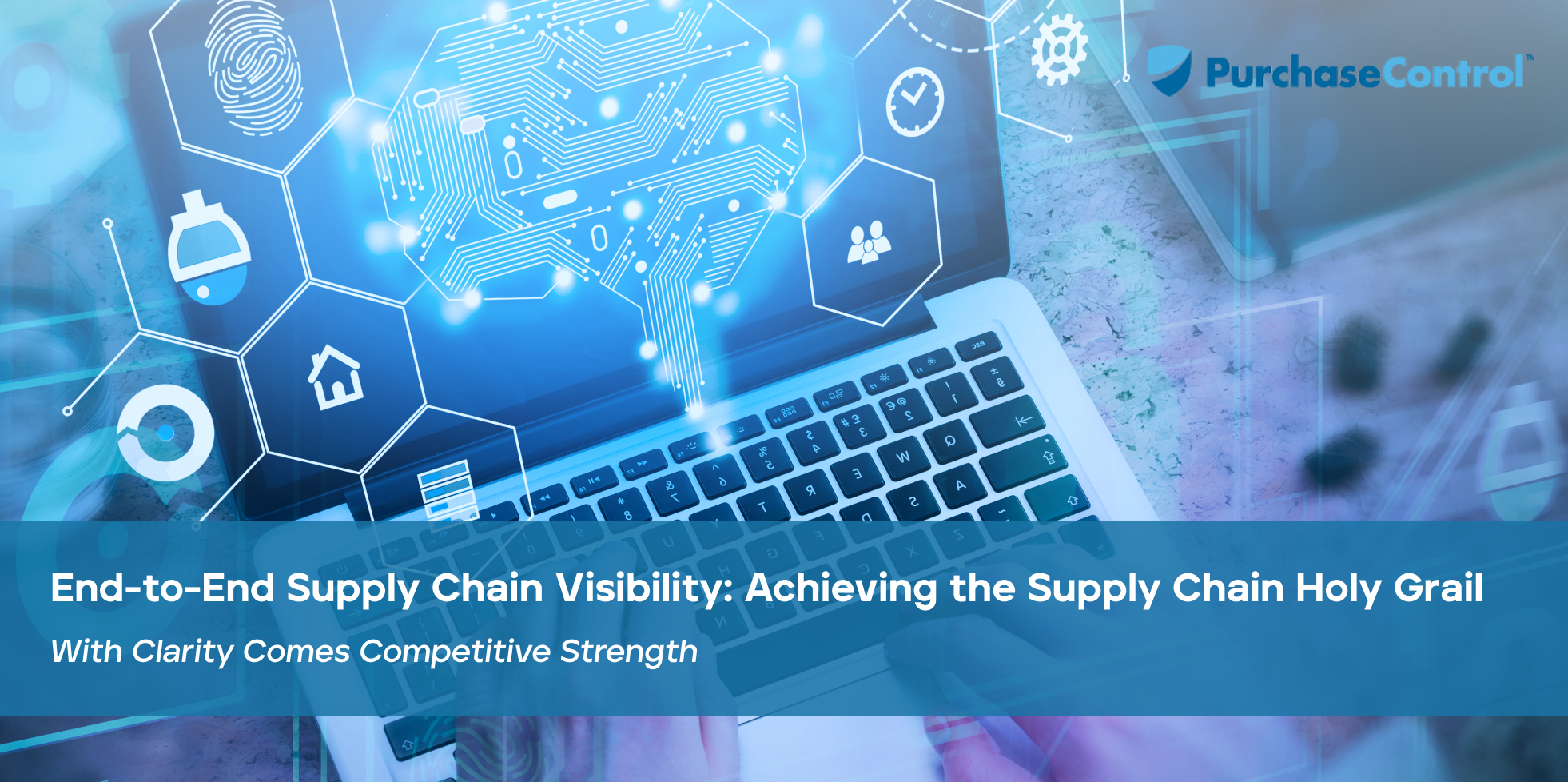Complex, time-consuming, and sometimes frustratingly opaque, supply chain management (SCM) poses a serious challenge for many organizations. From small businesses and startups to globe-spanning conglomerates, getting an optimal return on investment (ROI) requires companies to juggle spend activity, logistics, risk management, and supplier relationships. And the unfortunate truth is, without end to end supply chain visibility, one or more of those balls are going to be dropped—with costly consequences.
Taking the time to understand what end to end supply chain visibility is, what it can do, and how you can obtain it for your own business will put you on the path to improving your own cost effectiveness, profitability, and competitive strength.
What is End to End Supply Chain Visibility?
Frequently abbreviated to E2E, end to end supply chain visibility is transparency at all stages of supply chain management from procurement through delivery of finished goods to customers. This transparency is made possible by carefully monitoring each step of the process, capturing all related data, and organizing it in a centralized data management space, where it can be reviewed, analyzed, and, in time, mined for actionable insights that improve business processes, long-term financial planning, and strategic decision making.
As a rule, end to end supply chain visibility covers six primary areas:
- Procurement and inventory management
- Finance
- Logistics
- Operations
- Quality control
- Sales and customer service
Complete visibility in each of these areas is essential for proper data analysis. However, it’s also a key part of ensuring team members have complete and accurate information they need to communicate and collaborate effectively to meet stakeholder and customer expectations, innovate and enhance product offerings, and optimize business processes to build value and support organizational goals.
“According to a 2017 survey conducted by GEODIS, just 6% of responding firms had achieved their goals for end to end supply chain visibility, despite the fact that 57% considered effective supply chain management to be a competitive advantage, and that obtaining such visibility had become the third-highest priority for all firms.”
How Does Improved Supply Chain Visibility Improve the Planning Process?
The argument for achieving real-time visibility across your supply chain is a compelling one. Global supply chains are complex and require careful management in order to yield the best possible pricing and terms with the least amount of acceptable risk.
That’s a fine line to walk, and as the COVID-19 coronavirus pandemic so dramatically demonstrated, companies without full and real-time visibility into their supply chains quite often lack the necessary resilience to roll with the punches of business disruption.
Companies who make the necessary investments digital transformation—which usually includes the implementation of a purpose-built solution such as PurchaseControl—to obtain the necessary procure to pay (P2P) automation, risk management, supply chain management, and supply chain visibility solutions are not only more resilient and agile, but more able to reap the benefits of end to end supply chain visibility.
Optimized supply chain visibility improves supply chain performance in several important ways:
- Full monitoring of supply chain processes yields clear and complete data for analysis, financial reporting, and evaluating supply chain operations using metrics such as key performance indicators (KPIs).
- Real-time visibility promotes clear communication and fosters a collaborative approach between internal teams and key suppliers and service providers, strengthening supplier relationships, simplifying strategic sourcing, and supporting the development of shared initiatives for growth and innovation.
- Better visibility also simplifies concurrent process optimization and digital transformation initiatives.
- Improved responsiveness; major supply chain disruptors are more readily anticipated and mitigated, allowing more time to develop contingency measures or, better still, deploy those already developed using data analysis.
- Inventory management is improved through better demand forecasting, more accurate safety stock management, and turnover rate optimization.
Taken together and supported by cloud-based software solutions, these benefits have a strongly positive impact on long-term financial planning and strategic decision making. The more complete and accurate the available data, the more insightful and strategically useful the insights mined from it will be. These insights, in turn, can be applied to improve everything from cash flow management to strategic planning and product development.
The Challenge of Reaching True End to End Supply Chain Visibility
The importance of complete supply chain visibility is clear. Sadly, obtaining it can be an exercise in frustration for many organizations.
According to a 2017 survey conducted by GEODIS, just 6% of responding firms had achieved their goals for end to end supply chain visibility, despite the fact that 57% considered effective supply chain management to be a competitive advantage, and that obtaining such visibility had become the third-highest priority for all firms.
The same survey revealed that while a full 41% of respondents prioritized data analysis and 39% prioritized the Internet of Things (IoT) and cloud computing, only 53% of those surveyed said they were meaningfully engaged in advanced and innovative supply chain management.
Without significant investment in the software tools and processes that support a truly digital supply chain, companies will likely struggle to obtain the kind of visibility they need to make critical business decisions, accurate and complete budgets and financial forecasts, and reach their goals for profitability, competitive performance, and growth.
Lack of technological investment is only part of the reason companies struggle to achieve a truly transparent supply chain, however. Many organizations are still mired in traditional operational ecosystems where upstream and downstream processes in both operations and procurement/accounts payable are regarded as separate entities rather than powerful partners in shared success. Focusing too much on one without optimizing the other creates a broken system wherein data is never as clear, accurate, and complete as it needs to be, and thus total visibility remains elusive.
Tips for Achieving Better Supply Chain Visibility
The best first step to achieving the kind of supply chain visibility you need to create a responsive, resilient, and versatile supply chain (and an agile business to go with it) is to set the stage for transparency with a proactive approach to data management and digital supply chain management.
A centralized, cloud-based data management solution like PurchaseControl provides a single hub for data collection and analysis while simultaneously streamlining your existing software environment.
- Templates, file standardization, and full integration with other applications (including existing enterprise resource planning (ERP), customer resource management (CRM), accounting software, etc.) ensure everyone’s on the same page, using the same file formats and processes.
- Robotic process automation, powered by machine learning, creates immediate cost savings by streamlining workflows while eliminating the need for human intervention in high volume, time-consuming tasks like data entry or invoice verification. Data quality, completeness, and availability increase exponentially while staff are freed to focus their time and skills on more strategic areas.
- Centering procurement as both a data center and a value creation station for your entire organization allows for complete visibility into all spend activity while process improvements and robust analytics improve budgeting, forecasting, cash flow management, financial reporting and planning, and long-term strategic development.
- Cloud-based, centralized data management not only allows for real-time visibility and access for team members, but allows them to leverage real-time data flowing in from upstream and downstream to:
- Refine logistics.
- Optimize operations.
- Connect finance with strategic planning, marketing, and sales.
- Maximize value chain efficiency from procurement through sales.
- Gain deep insights into the true value generated by every dollar spent.
Once you’ve primed your data ecosystem for visibility, you can use the tools at your disposal to:
- Develop, implement and monitor KPIs to identify areas in need of improvement (for both internal processes as well as vendor management KPIs such as lead times and service level compliance) as well as opportunities to grow key suppliers into supply chain partners in innovation.
- Target and eliminate weaknesses in your internal practices that lead to opacity, such as eradicating rogue spend through the use of guided buying and automatic integration of supplier contract data supported by vendor portals.
- Take control of inventory management, warehousing, and logistics across your entire supply chain by connecting and collaborating with relevant internal stakeholders at your own facilities as well as those operated by your suppliers and customers.
- Integrate new data streams as they become available to provide additional transparency and enrichment to your datasphere (e.g., integration of data from vehicles used by third-party logistics service providers, real-time updates from retailers regarding available stock on hand, etc.).
Full Supply Chain Visibility Helps You Plan, Innovate, and Grow
Trying to manage what you can’t see is a recipe for frustration, if not outright disaster. By investing in the tools and organizational changes you need to achieve true end to end supply chain visibility, you can plan for the future and make strategic decisions with confidence thanks to clear and complete data, well optimized supply chain processes, and the agility and resilience you need to compete in today’s complex global marketplace.
Automate, Innovate, and Optimize with Supply Chain Management Tools from PurchaseControl
Find Out How








